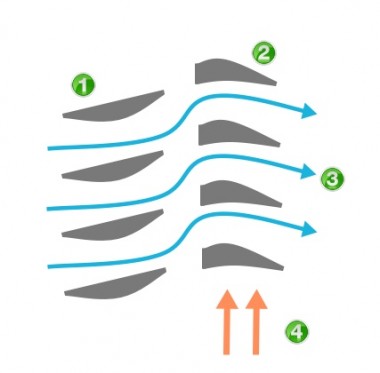Reaction Turbine
A reaction turbine is a type of steam turbine that works on the principle that the rotor spins, as the name suggests, from a reaction force rather than an impact or impulse force.
This video fully explains the diagram below, or read the step-by-step tutorial on how a reaction turbine works:
In a reaction turbine there are no nozzles to direct the steam like in the impulse turbine.
Instead, the blades that project radially from the outer edge of the rotor are shaped and mounted so that the shape between the blades, created by the cross-section, create the shape of a nozzle. These blades are mounted on the revolving part of the rotor and are called the moving blades.
The fixed blades, which are the same shape as the moving blades, are mounted to the outer casing where the rotor revolves and are set to guide the steam into the moving blades. Below is a simple diagram of reaction turbine blades:
Notice from the diagram of the reaction turbine above that:
(1) The steam enters through a section of curved blades in a fixed position.
(2) The steam then enters the set of moving blades and creates enough reactive force to rotate them,
(3) The steam exits the section of rotating blades.
(4) The direction of rotation.
There are three main forces that act to move a reaction turbine. First, from the reactive force that is created on the moving blades as it expands and increases in velocity as it moves through the nozzle shaped spaces between the blades. Second, from the reactive force produced on the moving blades as the steam passes through and changes directions. Third, and to a lesser extent, from the impact force of the steam on the blades helps rotate the reaction turbine.
